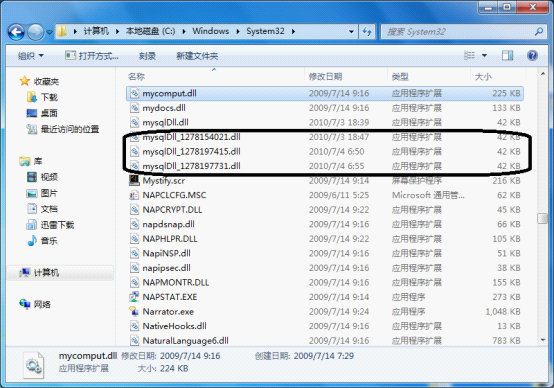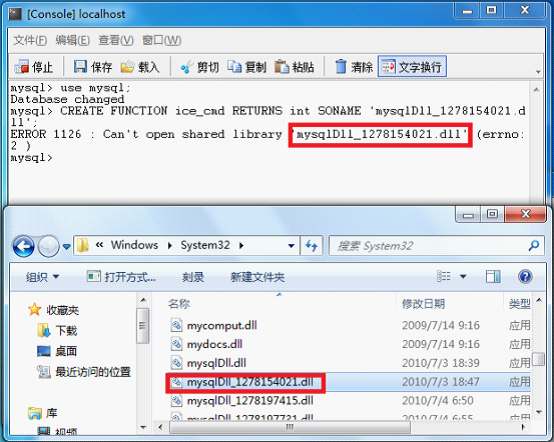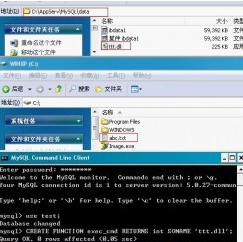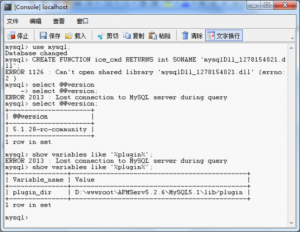A brief analysis of MysqlDoor function creation
Many times, we use mysqldoor to retain our server permissions, and sometimes we often use udf to escalate privileges. We often encounter this situation, Can’t open shared library ‘mysqlDll_1278197415.dll’.
The UDF privilege escalation tool written by Gushui Raocheng is used here. Figure 1.

First rule out several possibilities.
1. Killed by server-side anti-virus software.
2. The file is not written.
3. Because the file name generated by the script in the system32 directory is random, the program cannot find the file name.
1. I tested it locally and turned off the anti-virus software, so this situation does not exist and is ruled out.
2. Open the system32 directory, and the generated program lies quietly in the directory. Figure 2

1. Making the third assumption already eliminates the first two possibilities. Since we are afraid that the program is the problem, let's create it manually. (mysql5.0 or above does not support absolute paths, so it is generated under system32) Figure 3

Figure: 4
I went to Google for a while, but there is still no final answer on the Internet. It is better to just find one The article is the one about creating functions written by ninty. But after thinking about it for a while, I still didn’t understand it. Finally, I saw Wuming online. He has been in the PHP environment all year round and has a good understanding of MySQL.
After discussing with him, he gave the solution to the problem by placing the udf in the data directory in mysql. As shown in the picture: 5

He can succeed on his machine, but I just can't pass it. Finally, I used QQ to assist and let him operate my computer. In the end, I still couldn't get the answer, so I had to end it with a miracle.
In desperation, I went to the BK group for help. Ninty said it was a path problem. Later, I added Q and went remote, and it was solved. Finally, I finally understood his article, haha, don’t blame me here, I’ll sort out the information.
Before elevating privileges, confirm the mysql permissions. If it is version 4.0, use the path directly; if it is version 5.0, if it is not enough to put it in the system32 directory, just put it in data. If it is version 5.1, the operation will be more troublesome. Use
show variables like %plugin%;

as long as you put the file under this path, it can be executed successfully! But the prerequisite is that you must have directory creation permissions under the mysql directory.


Hot AI Tools

Undresser.AI Undress
AI-powered app for creating realistic nude photos

AI Clothes Remover
Online AI tool for removing clothes from photos.

Undress AI Tool
Undress images for free

Clothoff.io
AI clothes remover

AI Hentai Generator
Generate AI Hentai for free.

Hot Article

Hot Tools

Notepad++7.3.1
Easy-to-use and free code editor

SublimeText3 Chinese version
Chinese version, very easy to use

Zend Studio 13.0.1
Powerful PHP integrated development environment

Dreamweaver CS6
Visual web development tools

SublimeText3 Mac version
God-level code editing software (SublimeText3)

Hot Topics
 PHP's big data structure processing skills
May 08, 2024 am 10:24 AM
PHP's big data structure processing skills
May 08, 2024 am 10:24 AM
Big data structure processing skills: Chunking: Break down the data set and process it in chunks to reduce memory consumption. Generator: Generate data items one by one without loading the entire data set, suitable for unlimited data sets. Streaming: Read files or query results line by line, suitable for large files or remote data. External storage: For very large data sets, store the data in a database or NoSQL.
 How to optimize MySQL query performance in PHP?
Jun 03, 2024 pm 08:11 PM
How to optimize MySQL query performance in PHP?
Jun 03, 2024 pm 08:11 PM
MySQL query performance can be optimized by building indexes that reduce lookup time from linear complexity to logarithmic complexity. Use PreparedStatements to prevent SQL injection and improve query performance. Limit query results and reduce the amount of data processed by the server. Optimize join queries, including using appropriate join types, creating indexes, and considering using subqueries. Analyze queries to identify bottlenecks; use caching to reduce database load; optimize PHP code to minimize overhead.
 How to use MySQL backup and restore in PHP?
Jun 03, 2024 pm 12:19 PM
How to use MySQL backup and restore in PHP?
Jun 03, 2024 pm 12:19 PM
Backing up and restoring a MySQL database in PHP can be achieved by following these steps: Back up the database: Use the mysqldump command to dump the database into a SQL file. Restore database: Use the mysql command to restore the database from SQL files.
 How to insert data into a MySQL table using PHP?
Jun 02, 2024 pm 02:26 PM
How to insert data into a MySQL table using PHP?
Jun 02, 2024 pm 02:26 PM
How to insert data into MySQL table? Connect to the database: Use mysqli to establish a connection to the database. Prepare the SQL query: Write an INSERT statement to specify the columns and values to be inserted. Execute query: Use the query() method to execute the insertion query. If successful, a confirmation message will be output.
 How to fix mysql_native_password not loaded errors on MySQL 8.4
Dec 09, 2024 am 11:42 AM
How to fix mysql_native_password not loaded errors on MySQL 8.4
Dec 09, 2024 am 11:42 AM
One of the major changes introduced in MySQL 8.4 (the latest LTS release as of 2024) is that the "MySQL Native Password" plugin is no longer enabled by default. Further, MySQL 9.0 removes this plugin completely. This change affects PHP and other app
 How to use MySQL stored procedures in PHP?
Jun 02, 2024 pm 02:13 PM
How to use MySQL stored procedures in PHP?
Jun 02, 2024 pm 02:13 PM
To use MySQL stored procedures in PHP: Use PDO or the MySQLi extension to connect to a MySQL database. Prepare the statement to call the stored procedure. Execute the stored procedure. Process the result set (if the stored procedure returns results). Close the database connection.
 How to create a MySQL table using PHP?
Jun 04, 2024 pm 01:57 PM
How to create a MySQL table using PHP?
Jun 04, 2024 pm 01:57 PM
Creating a MySQL table using PHP requires the following steps: Connect to the database. Create the database if it does not exist. Select a database. Create table. Execute the query. Close the connection.
 The difference between oracle database and mysql
May 10, 2024 am 01:54 AM
The difference between oracle database and mysql
May 10, 2024 am 01:54 AM
Oracle database and MySQL are both databases based on the relational model, but Oracle is superior in terms of compatibility, scalability, data types and security; while MySQL focuses on speed and flexibility and is more suitable for small to medium-sized data sets. . ① Oracle provides a wide range of data types, ② provides advanced security features, ③ is suitable for enterprise-level applications; ① MySQL supports NoSQL data types, ② has fewer security measures, and ③ is suitable for small to medium-sized applications.






